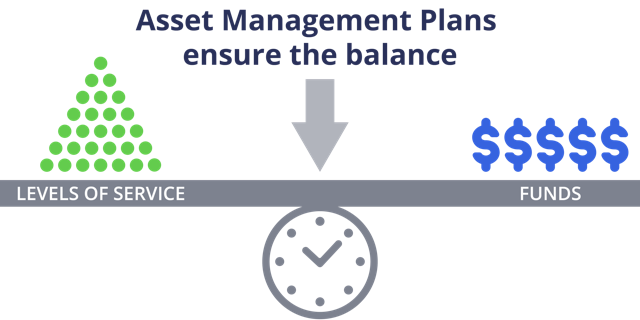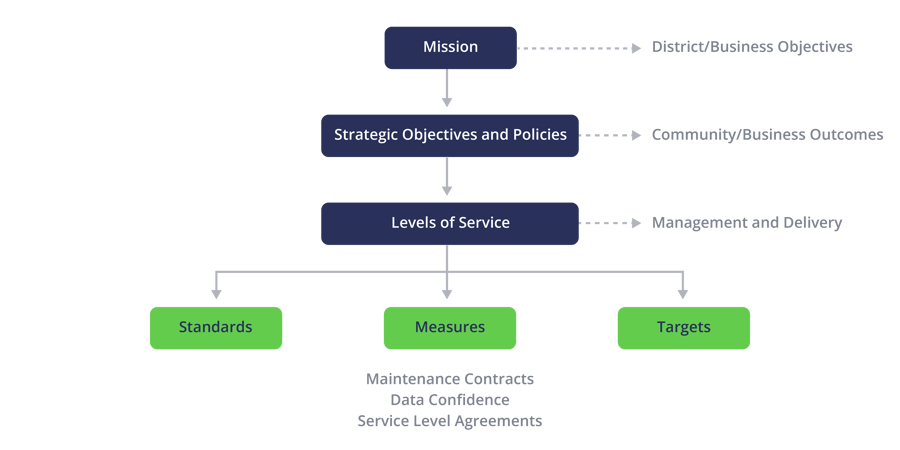What are Levels of Service, and why are they important?

Levels of Service are a fundamental building block of asset management planning. But if you’re new to asset management planning, how do you get started with Levels of Service?
What are Levels of Service, and why are they important?
To define Levels of Service (LoS), let’s look at the ISO 55000 standard for Asset Management. That defines it as “the parameters, or combination of parameters, which reflect social, political, environmental and economic outcomes that the organisation delivers”.
Physical assets are constructed or installed to deliver a service to the stakeholders. For example, a library service, or oncology, or fire service, or housing for the elderly, etc. The level of service statements define how the stakeholders wish that service to be delivered. The level of service statements become the justification for funding necessary to deliver the service.
In other words, it’s a way for an organisation to define, capture, and gain value from its assets.
In the asset management plan, there is merit in reporting how the assets meet the Levels of Service requirements. This provides stakeholders with confidence that they are delivering the service as required. These statements are reporting how the assets and asset portfolio are performing in respect of the level of Service requirements.
Levels of Service can be grouped into three categories:
- Operational: For example, is the asset clean and well looked after? Is the paintwork in good condition? Is the asset accessible to the people who need it?
- Service Provision: Is the asset portfolio large enough to serve the stakeholder requirements? Are there enough of these assets available for stakeholder needs? Is it fit for purpose?
- Implementation: When building a new asset will its capacity be suitable for the foreseeable future? Or will it have excess capacity that’s not needed – or will it be far too small?
Why are Levels of Service important?
As you can see from the definition of Levels of Service, they are wide-ranging and have implications within an organisation and also externally to users and other stakeholders.
Levels of Service are important because they:
- Align service delivery with organisational goals.
- Provide transparency and accountability.
- Allow repeatable and consistent measurement and reporting of inputs, outputs and outcomes.
- Help ensure efficiency in service delivery to stakeholders, which in turn may bolster positive relations with them.
- Help ensure long-term cost control and financial viability in delivering a service.
- Extract value and optimise the delivery of assets.
Helping you identify shortfalls
By defining and measuring Levels of Service, your organisation is able to identify shortfalls. IPWEA Practice Note 3 (‘Buildings – Building Condition and Performance Assessment Guidelines’) lists the following as typical shortfalls in building assets:
- Inadequate floor area for the users or tenants.
- Inefficient floor layout and/or building location.
- The location no longer caters for the user’s needs.
- Old technology that is inefficient and not cost effective to operate.
- Non-compliance with relevant statutory codes.
An asset survey that does not factor in Levels of Service may well miss these important shortfalls.
Planning new assets
Clarity around Levels of Service can assist you when planning new assets. This is because the Levels of Service will define the prudent minimum requirements for that asset to ensure it will continue to deliver an adequate service over the long term. It should consider the:
- Minimum capacity required for new assets.
- Minimum user requirements.
- Minimum standards for construction.
This in turn will form the background to the Architect’s or Procurement Officer’s brief in terms of:
- Engineering requirements
- Capacity
- Planning requirements
- Size
- Quality
- Environmental factors
- Design population.
Balancing Levels of Service with available funding
One very important aspect of Levels of Service is that you need to consider the funding available to offer your service. After all, no funds = no service. And declining funding invariably means reviewing and reducing the Levels of Service.
This is why Levels of Service are an integral part of decision-making in Asset Management Planning. It is the Asset Management Plan that balances the LoS with your funds.

How to get started with Levels of Service
The very first step is to have a clear mission statement for your organisation, as everything else will stem from this.
For example, an organisation whose mission statement mentions its eco-friendly stance will be very different to an organisation that prioritises scientific advancement and research. Which is different to a community housing provider that focuses on creating caring communities.
Once the mission statement has been defined, the organisation needs to set clear strategic objectives and policies. The Levels of Service can then be set, and must relate directly to these overarching goals.

The Levels of Service should include:
- Standards: Define the parameters.
- Measures: How will you measure the performance against the set standards?
- Targets: What is the acceptable pass mark?
The Levels of Service can be set individually for each asset, or you could apply them to an asset group as a whole. For example, all libraries could have the same standards, measures, and targets. Or each department in a hospital (renal, oncology, prosthetics) will have different requirements for space, beds, day patients, car parking etc.
You could also vary the standards by region. For example, a rural community in your area may have less demand for a certain asset type than a central city community.
How to define Levels of Service for your organisation
If you are starting with a blank sheet of paper, we can suggest a simple starting point.
First, record the current situation as it is. Say there are 40 residences for the elderly in a community of 10,000 people: ask if this is meeting requirements – or is there demand for more units, evidenced by a long waiting list? Or is the demographic is changing? This will establish a starting point for the definition of the measures and targets for the LoS.
This approach recognises that the current service has been paid for by past communities and represents what they required. The Levels of Service drive reality and should not be distracted by some enthusiastic or unsustainable ideal.
Are there any tools that can help with measuring Levels of Service?
There are software tools that can assist you with defining and measuring Standards of Service.
For example, the PQS (Property Quality Standards) section in SPM Assets software can be configured so you can record the standard requirement, and then identify whether that standard is met or not, to see if targets are being met. Standards can be applied across a group of assets, if desired.
The PQS functionality in SPM Assets has significant flexibility allowing the user to create libraries of LoS statements, enabling recording and reporting the different categories or service types.
The benefit of doing this work in SPM Assets software is that it can feed into your Asset Management Planning, and you also have the ability to run reports on how your organisation is performing with regards to Levels of Service.
Summary
Levels of Service help an organisation meet its stakeholders’ needs, and work towards achieving its strategic goals. They ensure that an asset is fit for purpose, whilst balancing costs and future demands. Shortfalls can be identified, and future assets can be developed strategically. The SPM Assets PQS functionality can help define measure and report Levels of Service, and this can feed directly into the organisation’s Asset Management Plan.
Next step
Contact us for a demo of SPM Assets software to see how it can help you with Levels of Service and Asset Management Planning.
Subscribe to our Broadcast
Our monthly newsletter featuring asset management tips and insights, and the latest SPM Assets news.